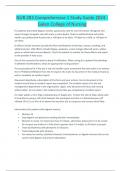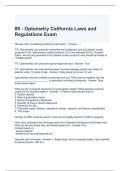NUR 283 Comprehensive 1 Study Guide 2024 - Galen College of Nursing For patients prescribed digoxin monitor apical pulse rate for one full minute. Recognize and report changes (irregular rate with early or extra beats). Teach to withhold dose and notify health care professional if pulse rate is <60 bpm in an adult, <70 bpm in a child, or <90 bpm in an infant. GI effects include anorexia (usually the first manifestation of toxici ty), nausea, vomiting, and abdominal pain. CNS effects include fatigue, weakness, vision changes (blurred vision, yellow -
green or white halos around objects). Teach the patient to monitor for these effects and report to the provider if they occur. One of t he scenarios this week is about IV infiltration. When caring for a patient that develops IV phlebitis manifestations, what are appropriate nursing actions? For any peripheral IV, if the site is red and swollen upon assessment the next action is to remove the IV. Phlebitis/infiltration from the IV requires the nurse to document in the medical record as well as complete an incident report. Document objectively a description of the facts and your actions. Do not document in the medical record that an incident report was completed. The incident report is for the risk management department in the organization. Again, only document the facts and nursing actions taken. Do not state in the medical record that you completed an incident report. For older adults a 19 o r 20g is indicated due to fragile skin. Protect the skin of older adults with IV insertion by using a soft cloth between the tourniquet and skin or a blood pressure cuff inflated 10 to 15 cm (4 to 6 in) above the insertion site to compress only venous blo od flow. Interventions for patients with digoxin toxicity: • Monitor VS • Stop digoxin and potassium -wasting diuretics immediately. • Monitor K+ levels. For levels less than 3.5 mEq/L, administer potassium IV or by mouth. Do not give any further K+ if the lev el is greater than 5.0 mEq/L or AV block is present. • Treat dysrhythmias with phenytoin or lidocaine. • Treat bradycardia with atropine. • For excessive toxicity, activated charcoal, cholestyramine, or digoxin immune Fab can be used to bind digoxin and prevent absorption. You previously learned about Total Enteral Nutrition (TEN) and tube feedings. Enteral feedings are instituted for a client who has a functioning GI tract but is unable to swallow or take in adequate calories and protein orally. It can be in add ition to an oral diet, or it can be the only source of nutrition. What are best practices for tube -feeding care and maintenance for these patients? See best practice boxes on page 1206 in IGGY 10 th edition med/surg book, Tube Feeding Care and Maintenance a nd Maintaining a Patent Feeding Tube. • For g tube or j tube rotate tube 360 degrees each day and notify provider if tube cannot be moved. • Check residual every 6 hrs or per agency policy for clients receiving enteral feedings to decrease the risk of aspirati on. Do not discard the residual. Follow facility policy as most or all of the residual should be replaced into the patient ’s stomach to prevent fluid, electrolyte, and nutrient loss. • For continuous feedings add only 4 hours of product to the bag at a time to prevent bacterial growth. Discard unused open cans after 24 hours. • Change feeding bag and tubing every 24 -48 hours. Replace irrigation set at least every 24 hours. • Do not use any food dye color in formula. • Keep HOB elevated at least 30 degrees during th e feeding and for at least 1 hour after the feeding (if bolus feedings) to prevent aspiration. For cyclic or continual feedings maintain semi -Fowler ’s position. • A clogged tube is the most common problem. Flush tube with water: o Every 4 hours during contin uous tube feedings o Before and after intermittent tube feeding o Before and after drug administration o After checking residual volume The NCLEX category Pharmacological and Parenteral Therapies has a section titled Parenteral/Intravenous Therapies (page 32 of test plan). Monitor intravenous infusion and maintain site is an activity statement noted for this part of the test plan. Registered nurses have a duty to ensure the infusion rate is correct and monitor the site for clinical indications the IV should be removed and rotated to a different site. Manifestations of phlebitis include redness/erythema, inflammation, and tenderness at IV site. Failure to detect an error with an IV could result in infiltration or extravasation. Monitor the rate and site close ly. Intervene if needed to prevent pain, swelling, compartment syndrome or, in extreme cases, an amputation of the affected limb. Try this practice question from the NCLEX® Connection: Reduction of Risk Potential, Therapeutic Procedures and provide a ratio nale for your response. A nurse is planning care for a client who has a platelet count of 10,000/mm3. Which of the following interventions should the nurse include in the plan of care? 1. Apply prolonged pressure to puncture site after blood sampling. 2. Adminis ter epoetin alfa as prescribed. 3. Place the client in a private room. 4. Have the client use an oral topical anesthetic before meals. Answer: 1 1. CORRECT: The nurse should implement bleeding precautions for the client who has thrombocytopenia (abnormally low platelet count). 2. Epoetin alfa is administered to the client who has anemia. This medication will increase red blood cells, which will increase Hemoglobin levels. 3. The client who has neutropenia is placed in a private room. If private room not available, roommate should also need protection from infection. 4. A topical oral anesthetic is used for the client who has mucositis. Clients can receive transfusions of whole blood or components of whole blood for replacement due to blood loss or blood disease. Blood com ponents include packed RBCs, washed red blood cells (WBC - poor RBCs), white blood cells (WBCs), fresh frozen plasma, albumin, clotting factors, cryoprecipitate, and platelets. Blood is usually administered over 3 hours via an 18 - 20g needle. Make sure the patient has an appropriately sized IV catheter before you obtain the blood for infusion then check the blood for discoloration or bubbles. Contaminated blood may appear unusually dark or contain gas bubbles. Always check blood with another nurse at the bed side then prime the tubing with 0.9NaCl before priming the tubing with blood. Remember we only administer blood with 0.9NS solution to prevent hemolysis. Never hang a dextrose or lactated ringer solution with blood. The nurse should remain with the patient for the first 15 minutes of the transfusion and monitor VS during this time. Once the first 15 minutes is complete without any s/s of a reaction, an LPN can monitor patient. If there is any indication of a reaction such as chills or hives the priority acti on is to stop the transfusion and change the tubing at the hub to avoid infusing any more of the blood in the IV tubing. Then notify the provider and send the blood bag and administration set (tubing) to the lab for testing. Respiratory and cardiac assess ment is important for all patients. Students sometimes have trouble remembering correct assessment technique for auscultating heart and lung sounds as well as correct descriptions of lung sounds. Where would you place the stethoscope to auscultate the pulm onic valve and what are considered normal breath sounds? Place the stethoscope on the second intercostal space, LEFT of the sternal notch, to auscultate opening and closing sounds of the pulmonic valve. This is the opposite side of the sternal notch for au scultating the aorta opening and closing, which would be second intercostal space, right sternal notch. You should know where to place the stethoscope to listen to lung and heart sounds. This is fundamental nursing knowledge. Normal breath sounds include b ronchial, bronchovesicular, and vesicular depending on the areas auscultated. See IGGY med/surg book for details on normal vs abnormal breath sounds. Characteristics of Normal Breath sounds are in table 24.4 in IGGY 10 th edition book. Auscultation is the p rocess of listening to sounds the body produces to identify unexpected findings. Some sounds are loud enough to hear unaided (speech and coughing), but most sounds require a stethoscope or a Doppler technique (heart sounds, air moving through the respirato ry tract, blood moving through blood vessels). Learn to isolate the various sounds to collect data accurately. • Evaluate sounds for amplitude or intensity (loud or soft), pitch or frequency (high or low), duration (time the sound lasts), and quality (what i t sounds like). • Use the diaphragm of the stethoscope to listen to high -pitched sounds (heart sounds, bowel sounds, lung sounds). Place the diaphragm firmly on the body part. • Use the bell of the stethoscope to listen to low -pitched sounds (unexpected heart sounds, bruits). Place the bell lightly on the body part. Blood is a medium for bacterial growth, any bacteria contaminating the unit will begin to grow if left outside of a controlled refrigerated temperature for longer than four hours, placing the client at risk for septicemia. Try this practice question and provide a rationale for your response: You are caring for a client who is 34 weeks gestation, has a hematocrit of 28 mg/dL. The provider prescribes iron supplementation. Which teaching should the nurs e provide? Select all that apply. 1. "Take the iron pill in the morning with eggs." 2. "Take the iron pill every other day for best benefit ”





